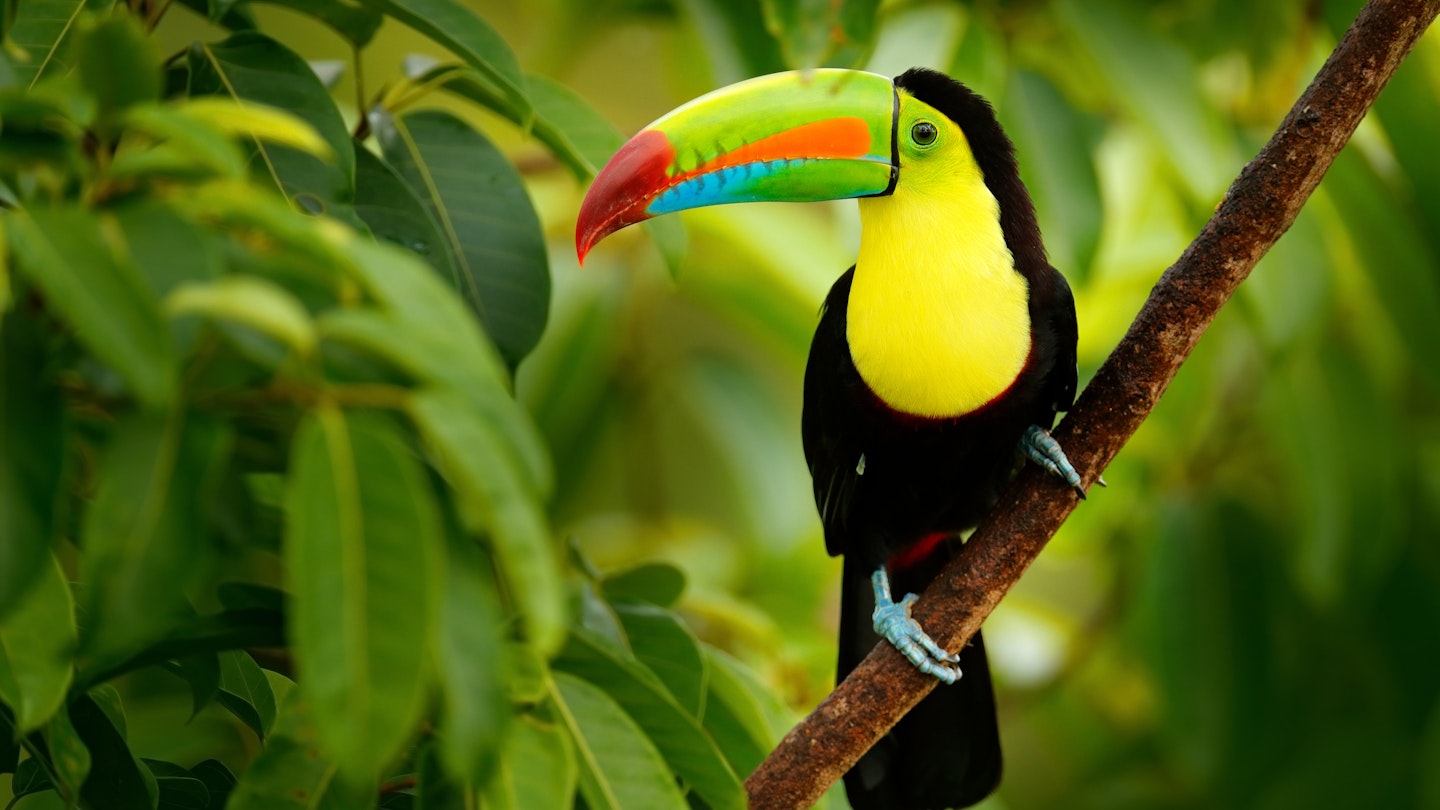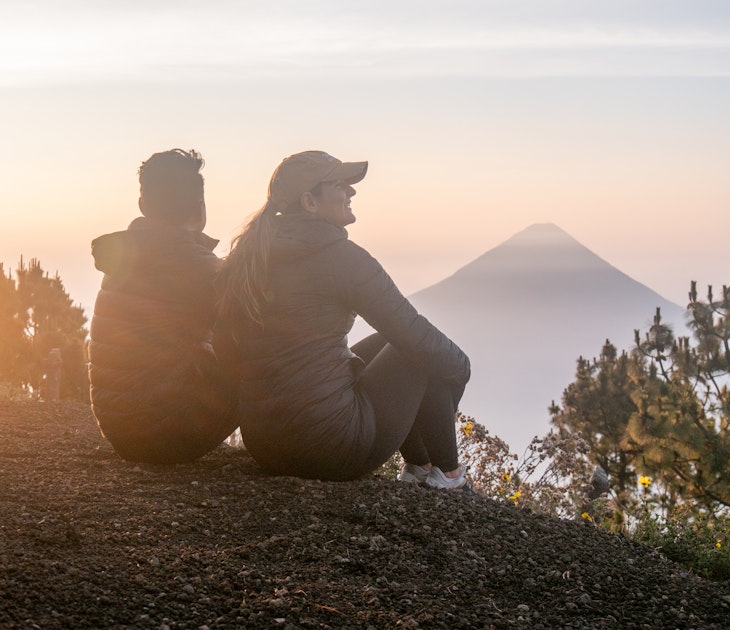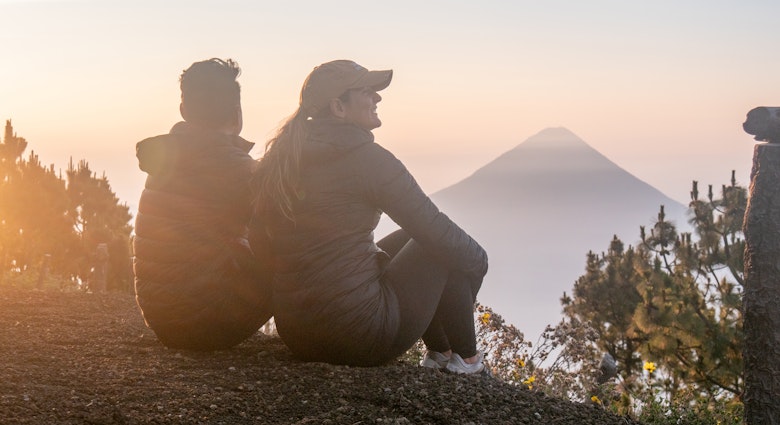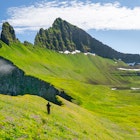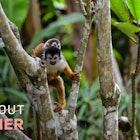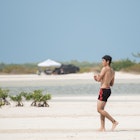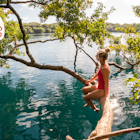Imagine a land that accounts for just 1% of the Earth's surface but over 8% of its total biodiversity. Imagine somewhere that crosses biomes as varied as wave-lashed beaches and humid cloud forests. That's Central America in a nutshell; a place where you can glimpse gigantic whales in the Pacific, spy stalking jaguars in the jungles, and swim coral reefs in the Caribbean.
Recent years have seen the region enter the frontline of global conservation. There are some serious and stark challenges ongoing, not least of all deforestation and habitat destruction in the face of climate change. But there has also been a big drive to establish contiguous nature reserves that foster and rebuild ecosystems to support the menagerie of species that make their home here.
This list of the best places to see wildlife in Central America touches on just a few of the highlights from Costa Rica's sloth-filled coast to the impenetrable Panamanian sierras.
Best for frontier vibes: Parque Nacional Darién in Panama
This is a wild, wild land. Just a mention of the name Darien is usually enough to conjure images of intrepid explorers hacking their way through impenetrable rainforest. So it is for the few stray groups of hikers that venture down.
You're looking at 5,790 square kilometers of land in Panama, touching the Pacific at one end and the Serrania del Darien mountains on the Colombian border at the other. No road goes through, and the only real towns are abandoned, colonial-era mining settlements.
The best area for wildlife viewing is around the long-out-of-use ranger station under Cerro Pirre. A couple of trails lead out from there into the densest parts of the jungle. What's living in that forest no one really knows, but there are regular reports of mantled howler monkeys, sloths, Baird's tapirs and even jaguars. Pack accordingly. This is the frontier.

Best for bird-watchers: Monteverde Cloud Forest Reserve in Costa Rica
Monteverde is a magnet for wildlife lovers. This gem of Puntarenas province is famed for its lush cloud forest habitats, which exist at altitudes of between 4,600 and 5,900 feet on the tips of the Cordillera de Tilaran. It covers more ecological zones than you could count on one hand and counts 90% primeval rainforest. Some stats, huh?
The flora and fauna, as you'd expect, is pretty darn startling. Let's begin with the birds, which run the gamut from the teal-plumed resplendent quetzal to the brazenly bold violet sabrewing hummingbird. Big mammals include white-faced capuchins and elusive ocelots. The plants go from vivid bromeliads to the biggest ferns you'll ever see.
All of that's fantastically knitted together by a series of well-marked trails that sometimes cross soaring canopy bridges suspended over the woods. Binoculars are a must for peering through the vegetation at birds and whomever else you manage to spot. So are waterproofs since cloud forests are famously wet. Generally speaking, though, Monteverde has some of the most accessible wildlife viewing in Costa Rica.

Best for snorkeling and diving: Ambergris Caye in Belize
Talcum-powder beaches and five-star hotel resorts have turned this dash of barrier isle on the eastern haunch of Central America into a real R&R escape. But there's no reason you can't interrupt a pool session for a trip out to the Belize Barrier Reef, which encompasses a whopping 30% of the Mesoamerican Barrier Reef System, the second largest on Earth.
The main place to go is the Hol Chan Marine Reserve on the southwest side of Ambergris Caye. It consists of four zones, ranging from the rich seagrass beds that support the marine life to the multi-colored underwater gardens that count more than 50 different coral species. Zone D is colloquially called Shark Ray Alley. There, it's possible to swim with nurse sharks, stingrays, and even the occasional passing whale shark.
Most tours provide snorkeling and diving equipment as part of the package. There are also strict no-fishing policies in place across much of the park.
Best for a turtle arribada: Refugio de Vida Silvestre La Flor in Nicaragua
Rivas province in the deep southwest of Nicaragua is the jewel in the crown of the country's ever-developing travel industry. Waves are what really put in on the map and board-touting surfers now flock into San Juan del Sur by the thousands. But there are also unique reserves, topped off by the Refugio de Vida Silvestre La Flor (La Flor Wildlife Refuge).
One creature steals the show: Olive ridley turtles. Thirty thousand of them to be exact. They flood this cinnamon-tinged sand stretch just south of the surf town from July to January, with the biggest crowds hitting in mid fall. That's the best time to come because it gives the highest chance of seeing an arribada, when multitudes of olive ridleys clamber onto the beach all at once.
Most newborn turtle releases and sightings of adult mothers laying eggs at La Flor occur in the dark of night. You'll need a good bug spray to survive the onslaught of mosquitoes that emerge then during the Nicaraguan wet season. The nearest hotels are at Playa El Coco just to the north. The beach is totally out of bounds during the nesting period if you don't have a qualified guide.

Best for diversity: Parque Nacional Corcovado in Costa Rica
Arenal and Monteverde are small fry compared to the mighty Parque Nacional Corcovado (Corcovado National Park). Spreading over a map-devouring 424 square kilometers on the huge Osa Peninsula, this is a part of Costa Rica that conservationists wax lyrical about over their wheatgrass shots and copies of Nat Geo in the morning.
It's been called the "most biologically intense place on Earth." It's easy to see why. Three hiking routes converge here – one on the coast, two inland. They are each a ticket to such a rich montage of wildlife that you'd think you were dreaming.
Through the jungles on the El Tigre Trail and crossing from Estacion Sirena, you can see howler monkeys, spider monkeys, silky anteaters, and sloths, along with endangered Baird's tapirs if they decide to emerge by day. On the shoreline, caimans meet bull sharks in the rivers, so be careful where you step, while humpbacks patrol the wave-lashed bays.
As you might expect, the Corcovado is one of the harder-to-reach corners of the land of Pura Vida. Access and planning are usually done in the nearby town of Puerto Jiménez. Strict new conservation measures mean that you can only enter for one or two days maximum, and all groups need a certified guide. Trails are hard here, too, so saddle up in strong walking boots, bring gnarly bug spray, and proper hiking stuff.
Best for tropical rainforest: Reserva de Biosfera Bosawás in Nicaragua
Matched only by the mighty Amazon, the Reserva de Biosfera Bosawás (Bosawas Biosphere Reserve) covers the second-largest tract of tropical rainforest in the Americas. It's estimated to be around 20,000 square kilometers in all, supporting ecosystems for a quarter of a million insects right up to apex predators like the mysterious jaguar.
You'll have to do some legwork to get here. First, get permission to enter the park at the office in Siuna, Nicaragua. They can also help you organize a guide, which is compulsory – expect to pay US$20-30 a day. Then, it's an onward bus to one of the entrance points or trailheads. Options include an attempt at the rugged heights of Cerro Saslaya or the jungle walks of Peñas Blancas.
It won't be a walk in the park. Like Darien further south, the Bosawás is undeveloped jungle. It's for those with a bit of survival training and a willingness to share undergrowth beds with snakes and golden frogs. Ask your guide for a list of gear before leaving Siuna. It's likely to be extensive.
Best for seeing jaguars: Selva Maya in Belize
The Selva Maya extends a whopping 40 million acres across Central America, rolling through Guatemala and Mexico. But it's the part that spills into western Belize that's getting all the attention right now, mainly thanks to an ambitious 2021 land purchase that added nearly 100,000 hectares to the country's protected landscape.
The aim was to put a stop to ever-encroaching agricultural development and ring-fence one seriously biodiverse part of the planet. The new reserve joins with the Rio Bravo Conservation Area to link up forests that host more jaguars per square mile than anywhere in the region, four other big cats, and an estimated 350 bird species.
Chan Chich Lodge is the only accommodation option set deep in the confines of the expanded Belizean Selva Maya. There's a whiff of luxury about it, but they also organize guided day-walks that talk about the local medicinal plant life, night expeditions to spot margays and ocelots, and even safari-style game drives.
You might also like:
The 14 best beaches in Central America
Getting around Central America is easy by bus, plane and boat
Why Central America is great for budget travelers

